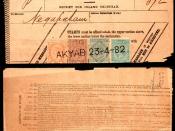Sexual Equality and Indian Government: An analysis of Bill C-31 Amendments to the Indian Act By Joyce Green This article deals with Bill C-31, what it stands for and how it has affected change for the Indians. Before Bill C-31 was passed if you were a status Indian women and married a non-status Indian man, you and your children lost your status and if you were a white women who married a status man, you received status. Also, Indians could be enfranchised, meaning they could sign their rights away. They usually did this for money. You could also be enfranchised if you went to college or went away to fight in the army.
Bill C-31 was passed in 1985. This allowed Indian to get their status back and the government couldn't enfranchise anymore. Bill C-31 changed sections of the Indian Act. The biggest and most important change was the removal of section 12(1)(b), which took away the status from Indian women who married non-status Indians or non-Indians.
Also Bill C-31 makes it possible for women who have lost status through section 12(1)(b) and their children to get their status and band membership back.
This article recounts the Sandra Lovelace case that took place in 1975. She believed that Canada was in violation of several rights. She took it to the United Nations Human Rights Commission. The Commission couldn't find Canada guilty of sexual discrimination, because of the fact that she had gotten married before Canada had made the Covenants official. After this important case women groups and equal right groups pressured the federal government of section 12(1)(b). This issue reached the Conservative government who registered Bill C-31.
Under Bill C-31, INAC must report to Parliament about bands controlling membership and the impact of the amendments of Indian nations.


